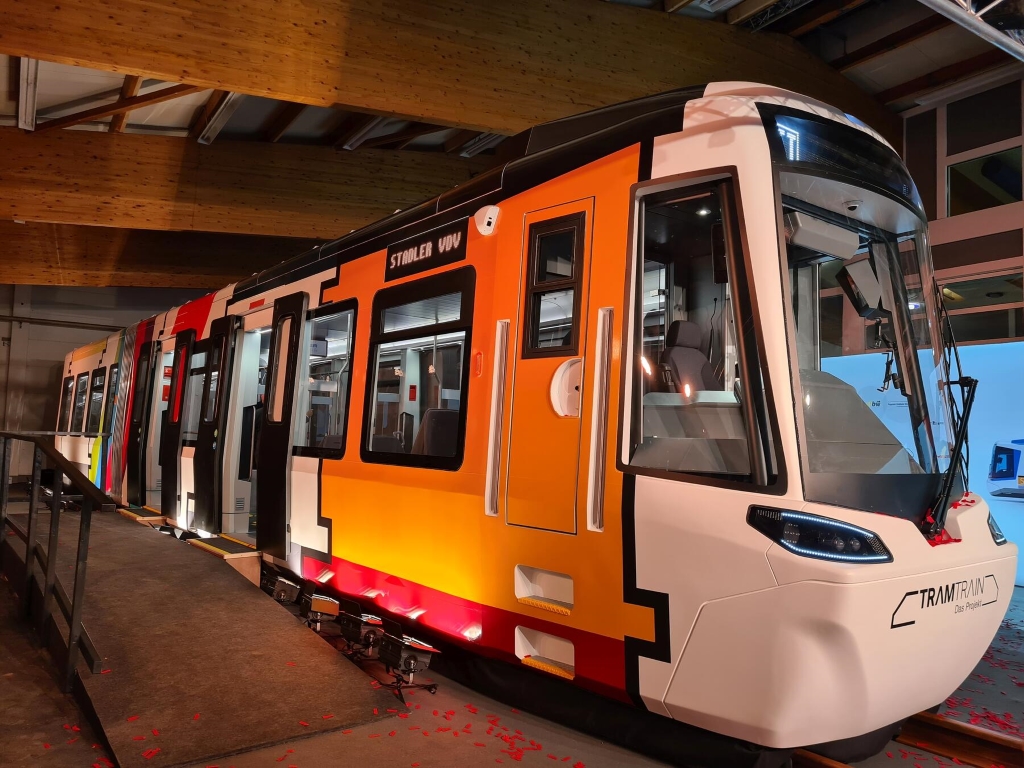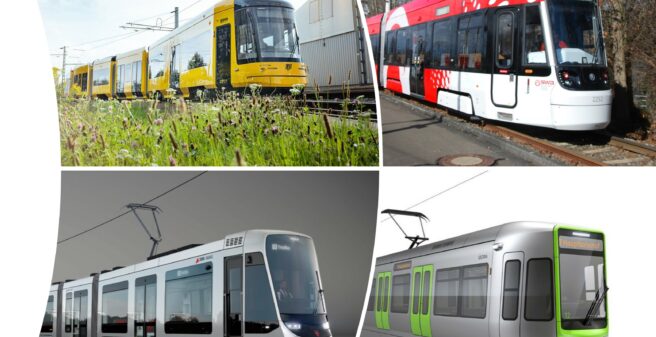
The market overview as per 1 March 2023
Already awaited by many transport experts and friends, the 23th edition of this lists is now online – it already dates back to 1993.
Slow reduction of the delivery backlog
In the list, the years originally agreed upon when the contract was awarded are the once mentioned as “Delivery” date. This makes it easy to identify a delay in delivery when comparing it to the current status. No uniform trend can be identified here, neither in the duration of the delay nor for individual manufacturers. Even in the last three years, which have been difficult in this respect, there have been vehicles delivered on time. And not only that, a company has also received the first vehicles on order well before the date originally planned.
The period between tendering and deployment is getting longer and longer
While the periods between tendering and awarding are mostly short, with exceptions confirming the rule, there is still a trend for the period between ordering and delivery to become longer and longer. For some time now, this has already been evident in the planned delivery dates specified in the contract award. The manufacturers are thus taking into account the possible delays in the production process due to external, but also internal events, which make reliable statements increasingly difficult. In the case of quite a few deliveries, it was possible to keep well within the specified timeframe, but there are also “outliers”, unless, as is increasingly common, prototypes for advance delivery were already required in the tender, but a start of delivery does not necessarily mean that the ordered figures will be reached continuously and quickly, because delays occur time and again. These are not always the fault of the producers, because the commissioning process is also becoming increasingly longer due to delays in the approval procedure. Excessive bureaucracy in the regulations on documentation for the technical supervisory authorities (TAB) as a basis for operating licences is now being met by departments thinned out in terms of personnel both at the plants and at the authorities, whereby the latter also apply different standards from one federal state to the next, and in some cases even within the states with different regional divisions. More and more frequently, especially in the case of technical innovations, additional expert opinions are subsequently required, the preparation of which can cost not only time but also a lot of money. So it is not surprising that there are voices in all areas of the industry urging changes here with the aim of speeding up certain processes. However, as long as the current situation does not change here, transport companies have to repeatedly ask the manufacturer to wait with the delivery of further vehicles because there is a lack of space to accommodate the units that have not been accepted.
Conversely, in recent years the recipients have had to complain about production deficiencies in the takeover procedure, which then took a long time to be remedied by the manufacturer. It is obvious that the practice of transporting a vehicle by lorry several thousand kilometres from factory to factory during production, each completing only a sub-step, may save costs but is not necessarily beneficial to the quality of the finished product!
Cost increases make calculations increasingly difficult
Price has always been one of the decisive criteria for awarding a contract. However, the lowest bidder does not always deliver the best offer, because the pure production costs are often tied up in a package with additional services, e.g. in the form of maintenance contracts, which are often already part of the tender conditions. With manageable production periods in earlier years, manufacturers could largely trust that the cost framework would be adhered to. Unfortunately, this has changed in the last two years due to external influences that cannot be planned. The longer the production of a vehicle took, the less the original calculation fits the current development. A special chapter in this context is options that have been granted, the costs of which are inevitably higher the later they are drawn. Appropriate escalator clauses are necessary here to cushion the risk for both sides. It is currently noticeable that options are sometimes taken out very quickly, often during the production phase of the first delivery. In the case of a company in Switzerland, they were recently confronted with additional demands for the redemption of a rather old option, which will probably now occupy the lawyers.
Market development between 2019 and 2022
| Typ | ordered | options | |||
| 2019 | Low-floor | 267 | 84 | ||
| Metro | 63 | ||||
| 2020 | Low-floor | 162 | 224 | ||
| High-floor | 135 | 48 | |||
| Total | 297 | 272 | |||
| Metro | 398 | 270 | |||
| 2021 | Low-floor | 197 | 254 | ||
| Tram Train | 120 | 141 | (only German operators) | ||
| High-floor | 52 | ||||
| Total | 369 | 395 | |||
| 2022 | Low-floor | 150 | 10 | ||
| Tram Train | 19 | 27 | |||
| High-floor | 114 | 263 | |||
| Total | 283 | 300 | |||
| Metro | 18 | ||||
The market is slowly heading towards saturation
After the “exceptional year” 2021″ with the large numbers of VDV Tram-Trains, numbers of vehicles (ordered and optioned) are again approaching the magnitude of orders the years before. While in the comparison period 2021-2022 there were still 16 operators that filled the order books of the manufacturers on the basis of initial tenders and the redemption of options, this time there are only twelve and only six awards are made on the basis of a tender, five redeemed options and one increased its order by a small number of units without a tender.
The number of high-floor light rail vehicles is also considerably higher than that of low-floor vehicles this time. The lion’s share of the orders for low-floor cars was again secured by Stadler, while the Spanish manufacturer CAF won two of the three orders for high-floor cars. Although CAF has been able to sell considerable numbers of its successful low-floor Urbos 3 model in neighbouring German countries in recent years, it has not been considered for tenders in this country. Only Freiburg im Breisgau has been using these vehicles since 2015.
In detail:
Bonn had launched a tender for 22 new vehicles for its fleet of high-floor light rail vehicles, which had to be expanded, only in spring 2022. The number of options was initially four, but was then increased to ten units. Linked to this was the decision to abandon the renewal of the B light rail vehicles, which had been successful for years and dated from the 1970s, as part of the so-called “second production”. The contract was awarded to CAF in the summer and the option was already exercised in the autumn, so that 32 vehicles are to be delivered from 2026, divided equally between the two operators SWB and SSB. The vehicle should correspond to the vehicle type ordered by Ruhrbahn Essen/Mülheim in 2021. For the manufacturer, high-floor light rail vehicles are a new component of the product range. However, CAF has been building railcars of various types for regional rail transport in Spain for a long time.
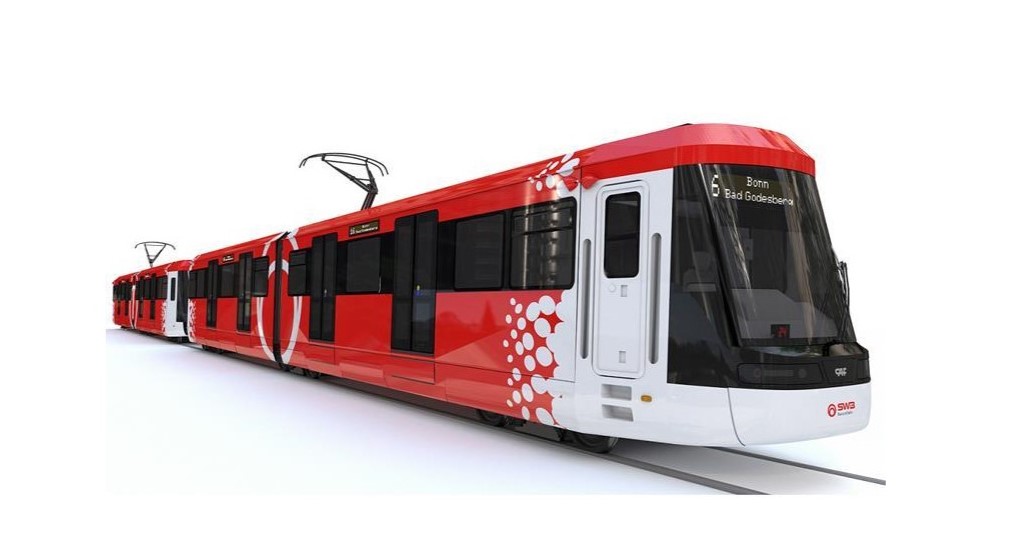
The order for the low-floor tramcars for the urban lines – 26 ForCity Smart cars have been ordered from Skoda – was increased by two units from an option. For the tram-train network of the Central Saxony Transport Association around Chemnitz, the local politicians had decided not to participate in the VDV’s joint order, but to go their own way. The reason for this was primarily to carry out the maintenance themselves. In 2020, the corresponding vehicles were put out to tender for the new operational constellation DC/AC (up to now there have only been DC/diesel vehicles). The plan was to initially deliver two test vehicles at the end of 2024, followed by 17 series vehicles in 2025. Up to 27 options were also envisaged in several partial series up to 2035. The award of the aforementioned numbers of units in the spring was then made with Stadler to the manufacturer of the VDV tram-train. However, the delivery of the three-part Citylink has been postponed for one year at a time. Surprisingly, the award does now include a maintenance contract by the manufacturer.
Cottbus, which together with Brandenburg and Frankfurt an der Oder participated in the collective order with Skoda last year, has not only honoured its option of 13 cars, but has also ordered two additional units. The company will thus receive 22 new railcars, which will enable it to phase out most of the Tatra KT4D articulated railcars that were fitted with a low-floor centre section in the 1990s.
Without tendering, Duisburg extended its current order of 49 Flexity-Classic low-floor cars by eight units to 57. This is possible under public procurement law, an ex-ante transparency notice is voluntary.
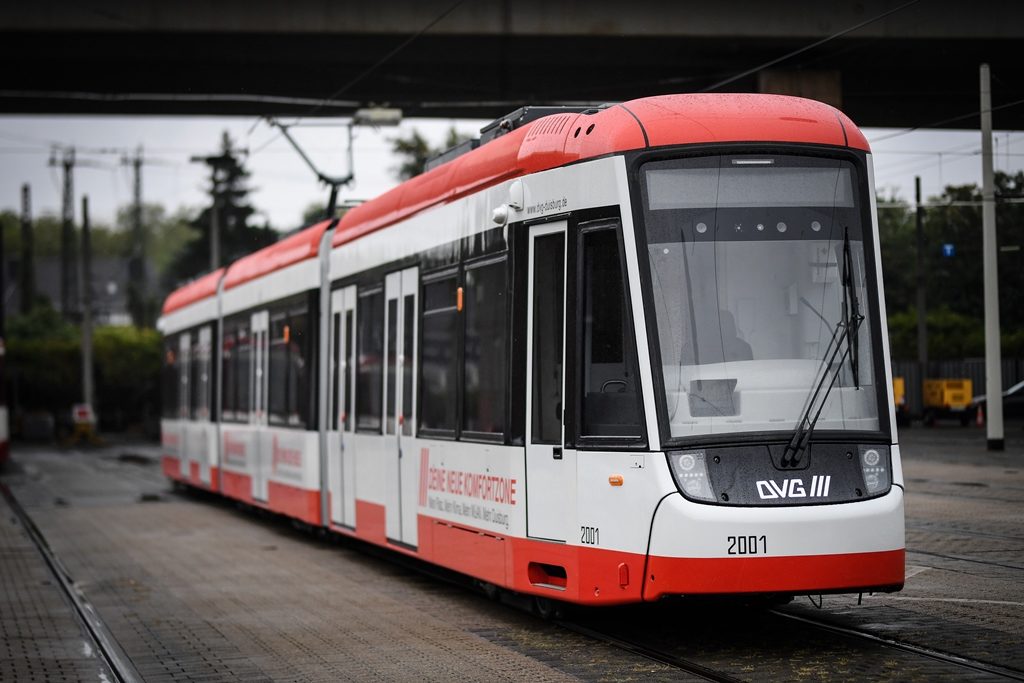
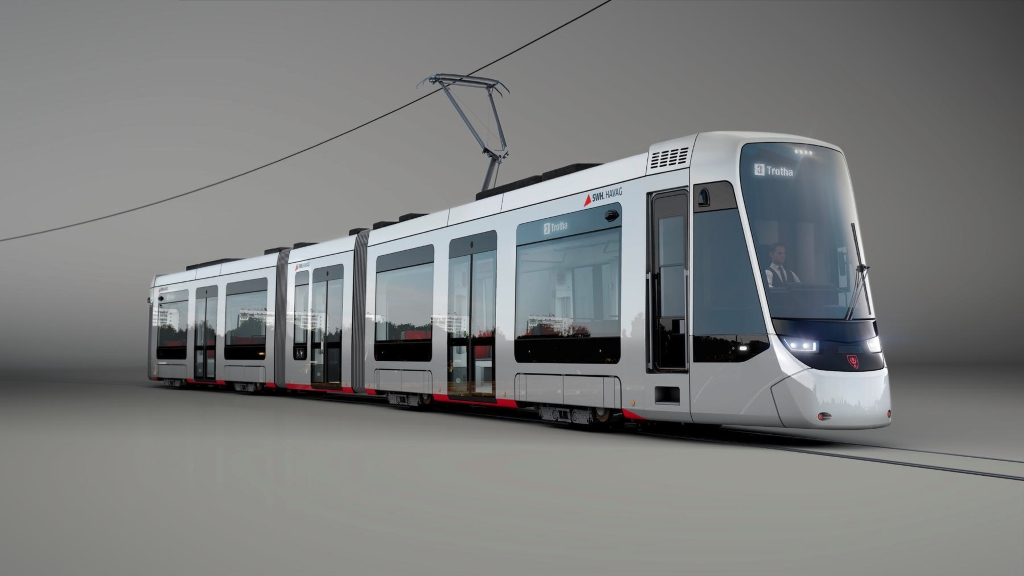
After Darmstadt and Rostock, the metre-gauge company of Halle an der Saale has also opted for the new low-floor railcar “Tina” developed by Stadler, Switzerland. They are to replace the first series of low-floor MGT6D cars delivered by DÜWAG at the end of the 1990s. Like these, the new vehicles will be built as bi-directional cars and the 56 units will come in two lengths as 30-metre-long three-part (39 units) and 45-metre-long five-part (17 units). Delivery is scheduled to start at the end of 2025. No options are planned.
The ÜSTRA, the public transport operator of the Lower Saxony state capital Hanover, also awarded the contract for the delivery of the now 4th generation of high-floor light rail cars to CAF. The TW 4000 series is based on the predecessor type TW 3000 built by Heiterblick. In addition to 42 firm orders, up to 233 options are planned in five tranches until 2035. The new vehicles will replace all existing eight-axle 6000 series trains as well as the railcars purchased for EXPO 2000 in the years 1997 to 2000.
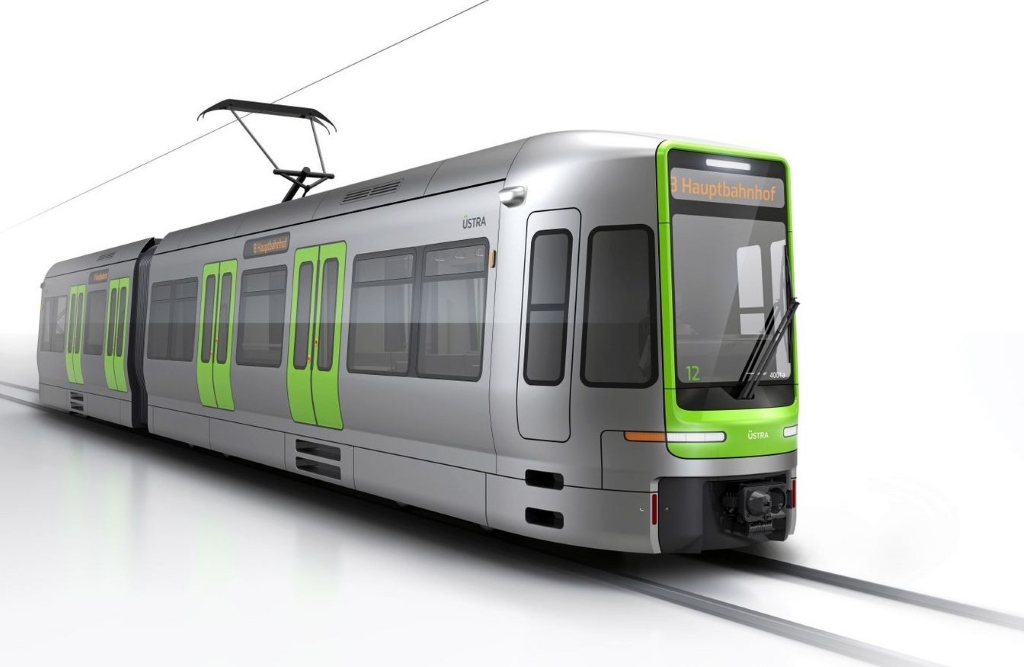
Stuttgart, as another operating company for high-floor railcars, again placed the order for the further delivery of the DT 8 double railcars with Stadler. In addition to 40 firm orders for the now 16th partial delivery, there are also 30 options. The DT 8.16 will replace the predecessor series DT 8.4 from the mid-1990s, which will then be in service for 30 years and more. The DT 8.16 are to be revised in both technical and design terms compared to the predecessor series. Stadler has been building the double railcars for Stuttgart’s light rail system since the DT 8.12 series. Delivery is scheduled for 2025 onwards.
With the award of its contract, Rostock is tackling the replacement of the first generation of low-floor coaches delivered in 1994-96 and, in doing so, became the third company after Darmstadt and Halle an der Saale to opt for the new TINA vehicle type from Stadler. A total of 28 units were ordered in a three-part version for single-floor operation, with an option for ten more. Ten of the DÜWAG/DWA 6NGTW/WE are to be overhauled and remain in service.
If one compares the vehicles branded TINA, which were ordered in large numbers within a relatively short period of time and without any practical experience, it can be seen that although they have the same name, some of them have considerable differences in construction. A total of 189 units have currently been ordered by five companies and 74 have options. In addition to the orders from Germany, there is also one each from Switzerland (Baselland Transport with 25 units) and The Hague in the Netherlands with 56 (+44 options) units. What they all have in common is the eponymous new type of totally integrated low-floor drive in an adapted, very compact bogie.
What is new in service in 2022?
In Berlin, the delivery of the large-scale series of seven-section bi-directional Flexity F8Z cars was completed on time at the end of 2022. The series coaches had been delivered by Bombardier since 2012 and by Alstom after the takeover of the manufacturer. A total of 157 units of the F8Z were built, in addition to 34 short five-car F6Z and 40 seven-car F8E setters, for a total of 231 Flexity Berlin.
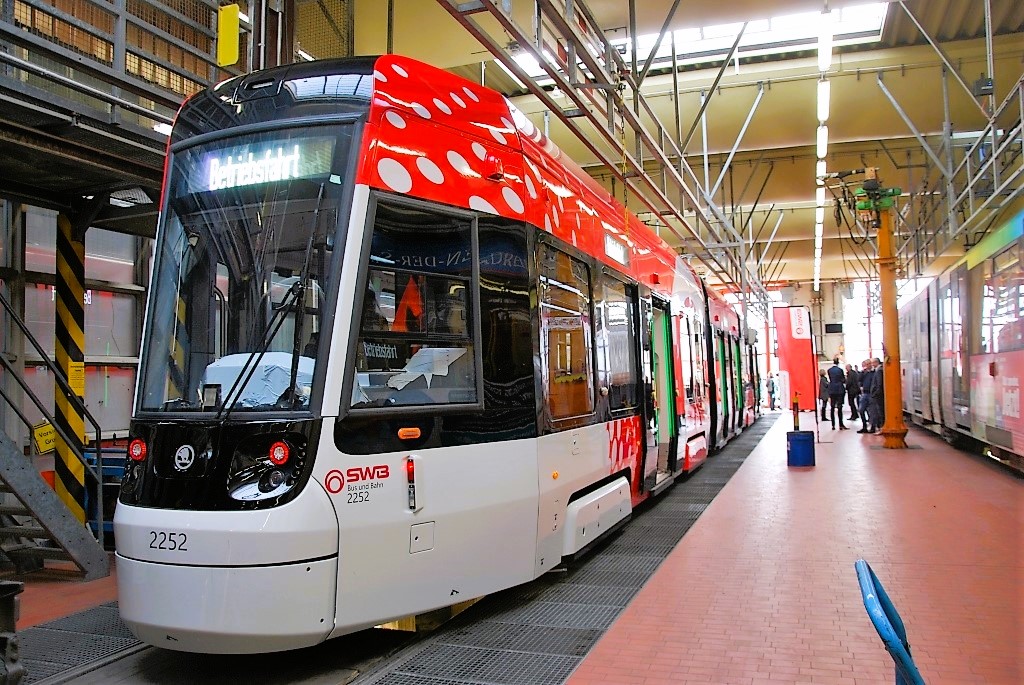
Bonn received the first of its three-unit low-floor two-door 41Ts ordered from Skoda at the end of 2019, about eight months late, in early February 2023. The municipal utility hopes that the 27 others will now follow quickly in order to be able to decommission the first generation of low-floor R 1.1 cars delivered in 1994. Their maintenance has caused increasing problems in recent years. Nevertheless, there is to be a buyer for the vehicles.
In Bremen, the delivery of the 4-part Siemens Avenio furnishing cars, called “Nordlicht” there, is coming to an end. Of the 77 vehicles ordered, only ten were still missing at the beginning of 2023. This will completely replace the series of the almost identical design supplied by AEG/ADtranz between 1993 and 1996.
At the HEAG transport company in Darmstadt, the delivery of the five-section furnishing wagons of the new type TINA built by Stadler in Bussnang (CH) began before Christmas with only a short delay. Prior to this, the first carriage of the model designated ST 15 in Darmstadt had already been exhibited at the Innotrans trade fair in Berlin. A total of 25 units are expected to be delivered by 2024, after an option for ten had been taken out for the initial order of 14 vehicles. Although two more units have already been delivered, HEAG expects a lengthy approval process due to the completely new drive technology and a deployment in passenger service only from autumn 2023. The ST 15 replaces the last series of eight-axle high-floor cars ST 12 built in 1990 by the Berlin Waggon Union and initially part of the first series of low-floor cars ST 13 from LHB from 1994.
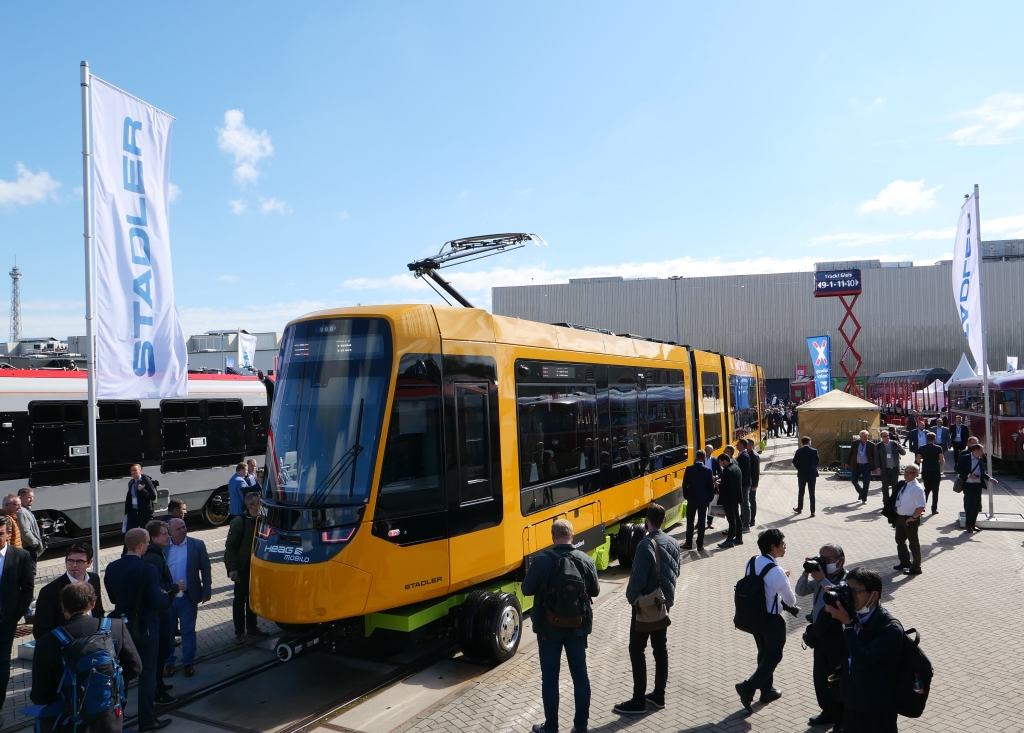
In Dortmund, the renewal of the B-type high-floor light rail vehicles by building new vehicles and refurbishing existing B-type vehicles was a difficult and “bumpy” process. In spring 2018, the Leipzig-based company HeiterBlick was awarded the contract for the delivery of 24 (+2 options) Vamos “Type Dortmund” over a longer period from 2021 to 2028. Parallel to this, the 64 existing vehicles built between 1986 and 1999 were to be thoroughly modernised and then made to resemble the new vehicles. The work for this was to take place in Dortmund. The completion of the first new vehicle manufactured in Leipzig had to be postponed again and again; it arrived in Dortmund at the beginning of December 2022, having previously undergone tests in the climate chamber in Vienna. The plan to modernise the existing vehicles in Dortmund had to be abandoned and will now also be carried out in Leipzig. A B-car has been there for some time as a prototype. However, it is foreseeable that the original schedule will have to be adjusted here as well.
In Dresden, the delivery of the five-unit, 2.65-metre-wide NGT X-DD built in the former Bombardier factory in Bautzen proceeded on time. The advance delivery of one unit arrived in November 2021, commissioning went smoothly, so that in March 2022 the delivery of the first tranche of 20 units could begin, which also went into passenger service quite soon. By February 2023, six units had arrived. From the option of 10 units, three were converted into firm orders in the spring of 2022, so that 12 units were still to follow.
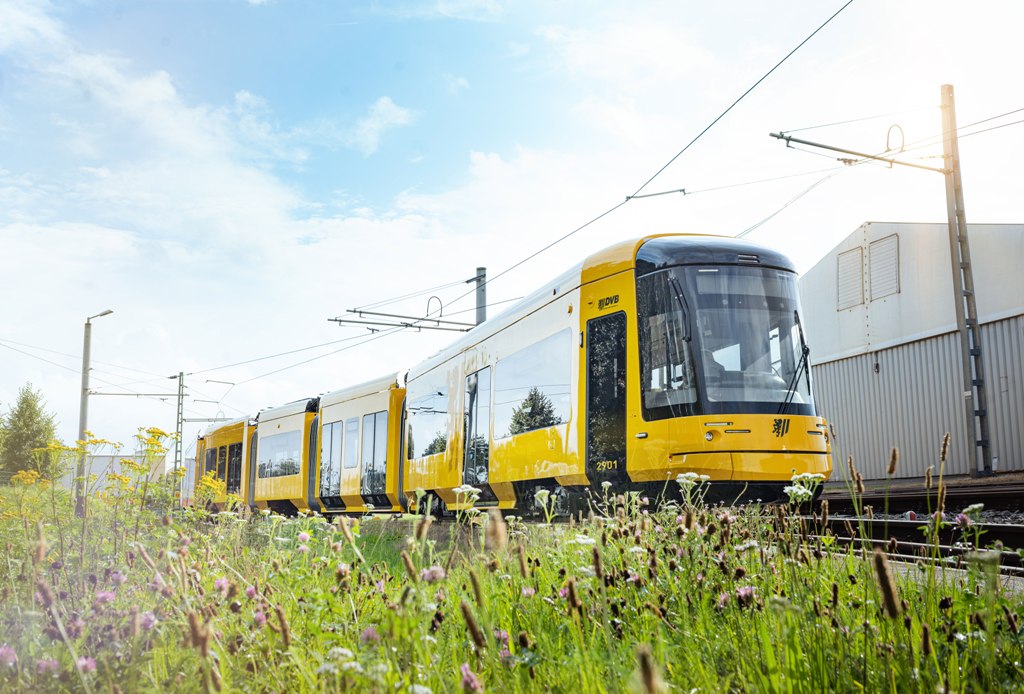
The problematic history of the six-axle high-floor light rail cars HF6 ordered jointly by Düsseldorf and Cologne to replace the light rail wagons B was described in detail here last year. After elimination of the problems and approval, another 14 of the 59 wagons ordered were delivered in Düsseldorf by the end of 2022, so that 23 wagons were available ready for use at the end of 2022, with the remainder to follow in 2023. The high-floor eight-axle GT8SUs, originating in the 1970s and still undergoing a thorough refurbishment and modernisation in 2012-13, are now being replaced and will in turn find a new home in Krakow, Poland. The first ones have already arrived there. Cologne did not have the problems but was the victim of Düsseldorf’s misery with regard to delivery. Nevertheless, 17 vehicles have been added in 2022 to the two preliminary vehicles delivered in 2020, the ten remaining will follow in 2023. Since both cities, but also all other operators, have decided to continue replacing the B cars with other vehicles, the HF6 remains a splinter class with all the disadvantages, e.g. for spare parts stock, which are not compatible despite the joint contract award.
The originally planned schedule is also wastepaper for the NF-2 low-floor wagons ordered for Duisburg, three-part bi-directional Flexity Classic wagons, which were ordered from Bombardier in 2017 and are now being handled by Alstom. While the delivery of the planned two “pre-delivery wagons” was still on time in 2020, there were subsequent delays due to Corona and material bottlenecks. Of the 55 additional vehicles ordered in the meantime after increases, one arrived in 2021, followed by three in 2022 and one so far in 2023. In order to obtain approval, however, the necessary documents were still missing at the end of 2022, so that deployment has not yet been possible. As there is not enough space for storage in Duisburg, further wagons will not be taken over for the time being. The company hopes to receive the approval in 2023, so that the trams can then be used in passenger service and the urgently needed replacement of the GT 10 NC-DU, which was purchased in 1986 and extended in 1996-97 with a middle section with low-floor access, can be initiated.
In Erfurt, on the other hand, the commissioning of the 14 seven-part Tramlink single-unit trams from Stadler Rail Valencia took place on time and without any problems.
In Frankfurt am Main, the order for the new type T low-floor wagons from Alstom goes back to 2018. Two preliminary wagons were to be delivered in 2020, which were then to be followed by 36 series wagons the following year. During the preparation for production in 2021, the number of four-part cars was increased by 12 to 22, so that initially 14 three-part cars were to be delivered. Things turned out differently: The first three-car X304 arrived in Frankfurt for the tram anniversary in late summer 2022, but was not used. It was not until December 2022 that the second carriage followed. Registration took place very quickly and from the beginning of 2023 one will run in regular service, the second will be used for staff training. The others are scheduled for delivery in 2023, to be followed seamlessly by the four-car X404s.
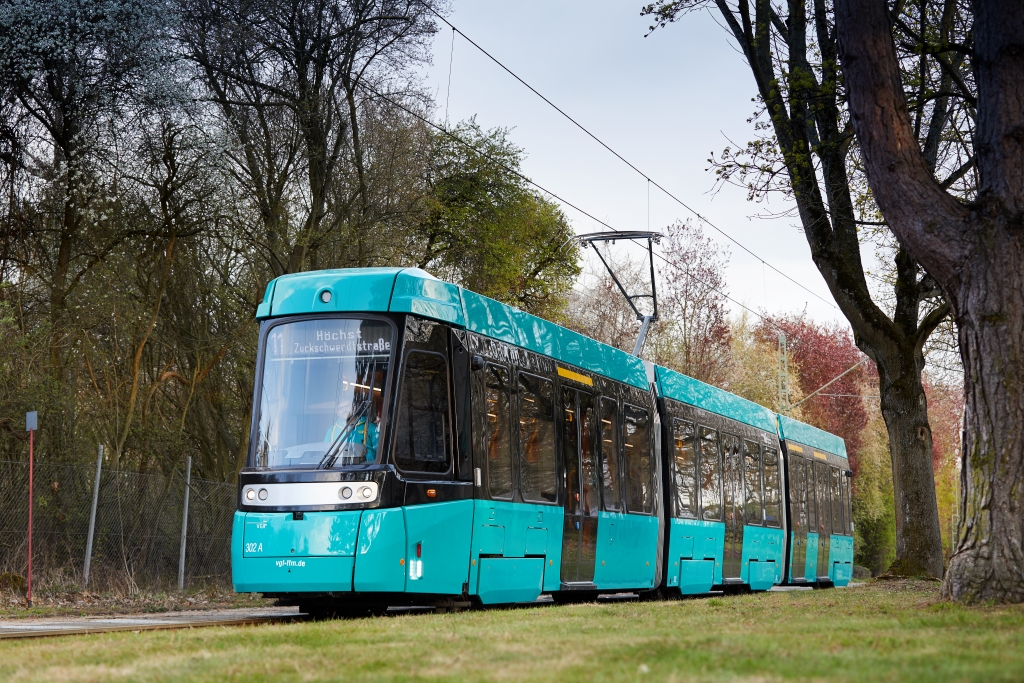
On schedule, the last tranche of ten NGT10 – XL four-seaters was delivered in Leipzig from the original Solaris factory in Poland, which was taken over by Stadler Poland. The technology comes from Cegelec. A total of 61 of these vehicles, called Tramino, have been delivered since 2016. They have made it possible to greatly reduce the use of high-floor Tatra four-axle vehicles.
In the Bavarian capital of Munich, it has unfortunately become a tradition that the approval of new vehicles sometimes takes several years due to the actions of the regional technical supervisory authority. This will presumably be the case with the 73 four-part Avenio T4.8 low-floor articulated trams, the first of which arrived on time in 2021. Like the eight units delivered in 2022-23, it has not yet been approved. This is despite the fact that the type has been running in Munich since 2013 and there was already an advance delivery of four units in 2017 (type T4.7).
The TAB Franconia, which is responsible for Nuremberg, shows that it can be done differently for its largely identical vehicles. The transport company ordered the first twelve Avenios at the end of 2019. While still in the production phase, the first two options of ten and four Tw were redeemed. Delivery began on time with two advance vehicles in 2021, registration in mid-2022, and a further four units arrived in the same year so that passenger service could begin before Christmas. Delivery of the remaining 20 units will take until 2024. The new four-units will create more capacity, should allow for densification and, from 2024, should also replace the twelve GT6N three-units delivered by Adtranz in 1995-89 6.
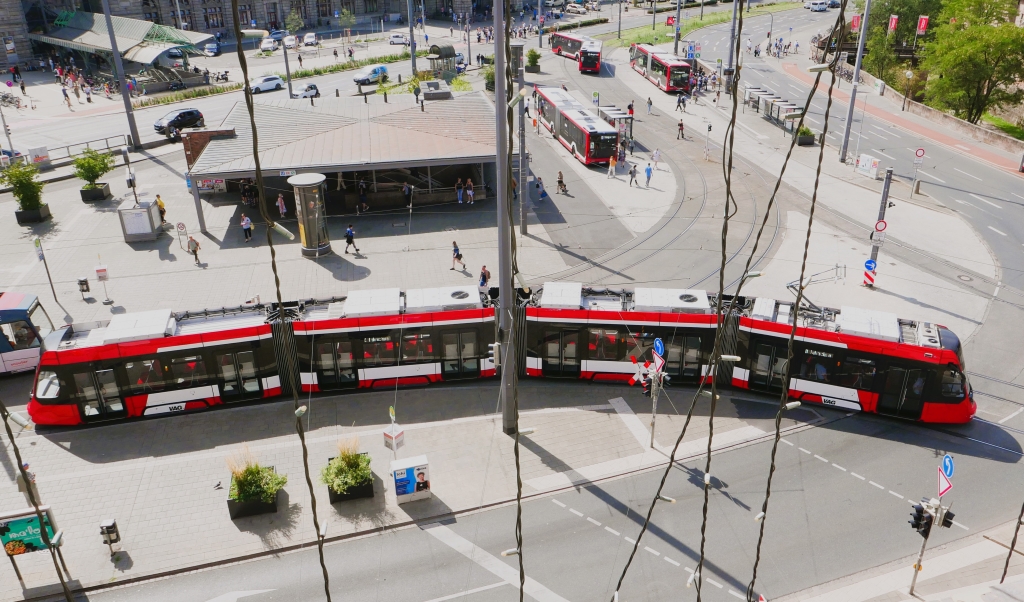
When the Rhein-Neckar Verkehrsgesellschaft (RNV) awarded the major contract of its tender for a new generation of vehicles in various lengths for the networks in Heidelberg, Ludwigshafen and Mannheim as well as the Oberrheinische Eisenbahngesellschaft (OEG) and the Rhein-Haardt-Bahn (RHB) to the Czech manufacturer Skoda-Transportation in 2018, this caused a stir in the professional world. Whereas today, with the exception of Heidelberg and the OEG, the companies use single-direction tram cars, the new fleet of the For City Smart vehicle family consists exclusively of bi-directional trams.
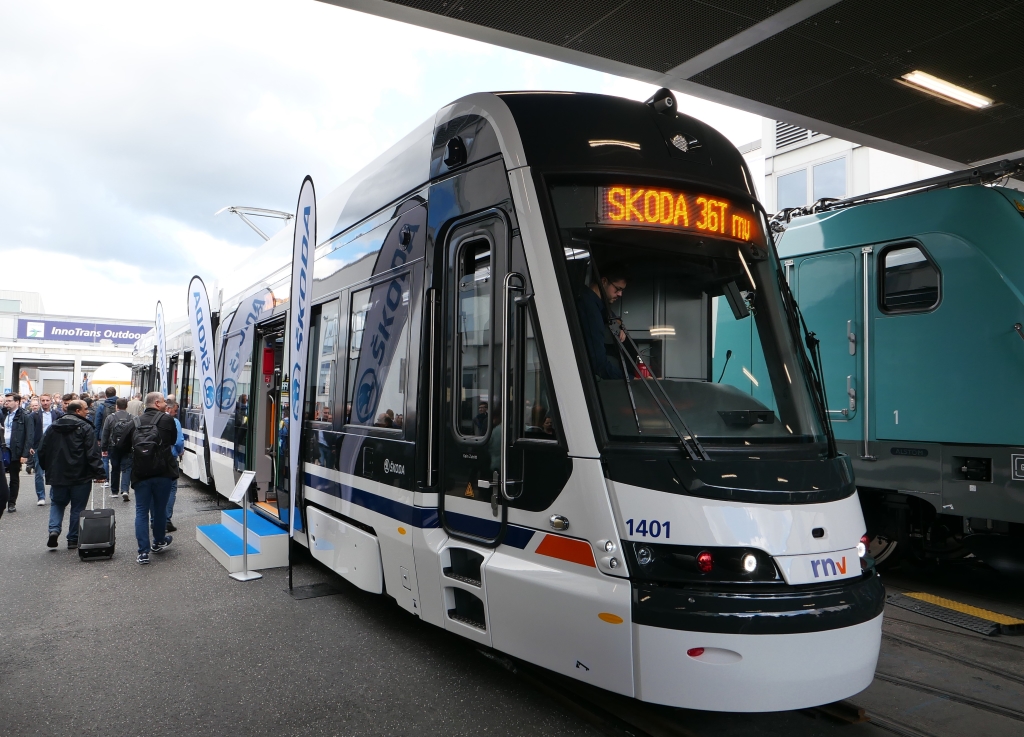
The 80 vehicles, divided into 31 three-section (type 36 T), 37 four- section (type 37 T) and 12 six- section (type 38 T) should be delivered between 2021 and 2023. There are also 34 options, the length of which will be determined at the time of drawing. The four- and six-car trains consist of two half-trains of two and three cars, respectively, which are short-coupled and continuously walkable. Here, too, the timetable was severely delayed, as only two three-car trains are on site at the beginning of 2023 and have been undergoing test runs since late autumn 2022. These created a need for re-construction, so that further deliveries and use in passenger service cannot be scheduled at present.
As in Bavaria with Munich and Nuremberg, light and shadow are close together in North Rhine-Westphalia with similar vehicles from the same manufacturer. The problems described at Duisburg did not occur with the delivery of 26 Flexity-Classic NF4 units from Bombardier/Alstom to the Ruhrbahn in Essen. The two pre-delivery railcars arrived on time at the end of 2021, as did the 22 series-production railcars from 2022 onwards, with delivery extending until 2024. By the end of 2022, five of them had been delivered and could soon be seen in passenger service after being quickly approved. They replaced the last series of high-floor light rail cars, type M from 1980-83. These are currently still needed for use on the line to Bredeney, where there is mixed operation of metre and standard gauge on high platforms in sections. For the metre-gauge stops located at street level, the M8Cs are equipped with folding steps. However, the section-by-section conversion of the platforms in the area of the joint operation to a low section and partial equipment with it in the rest of the line was not yet fully completed at the beginning of 2023. Until then, it will not be possible to do without the M-cars.
In Stuttgart, the delivery of the 15th series of double railcars for light rail operation is proceeding on schedule. Delivery of the 20 units began in 2021 and will be completed by mid-2023. The first new ZT 4.2 railcar for the rack railway, including the ZV 4 bicycle transport car, in 2021 was followed by the two remaining sets in 2022, so that the changeover to the new generation could take place. The ZT 4.2 were built in the Swiss Stadler factory in Bussnang, which is considered the competence centre for the manufacturer’s rack railway vehicles. The ZV 4 was supplied by the Steck company in Bowil (CH).
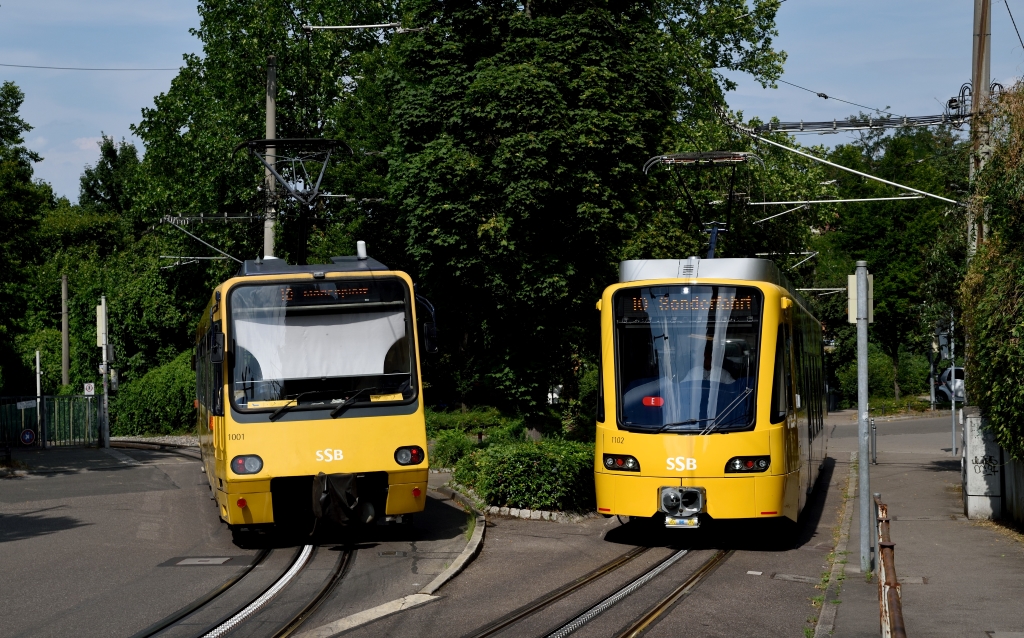
Something unusual happened in Ulm. There, another six railcars of the type Avenio M had been reordered from Siemens in 2021 from an option. The delivery was to take place from August 2023. The vehicles are urgently needed to increase the number of passengers on the new Line 2. The manufacturer’s announcement that it would be able to provide the cars eight months before the originally planned date was therefore a source of joy. Three of them arrived in Ulm in autumn, the others will follow from the beginning of 2023.
What else is delayed?
If you look through last year’s list of delivery dates, you will come across four orders where delivery was supposed to start in 2022 but no delivery has taken place: Augsburg, Frankfurt an der Oder, Jena and Würzburg. In the case of the first three cities, there are manageable delays, so that deliveries can be expected to begin in the coming weeks and months. The situation is different in the case of Würzburg. This order did not go smoothly from the beginning. Two years passed between the city’s announcement of its intention to launch a tender in 2017 and its publication. At the end of 2019, the contract was awarded to the Leipzig-based company Heiterblick. From 2021 onwards, 18 five-unit furnishing trolleys were to be delivered. The originally planned option of 20 more units was reduced to 9 vehicles because the expansion of the route network, for which more vehicles would have been needed, was also stuck in the political discussion. Nothing happened in 2021 and 2022, except for an announcement by the manufacturer at the end of last year that the vehicles would not be delivered until 2024. This also means that the use of the still existing eight-axle high-floor cars from 1968 and 1975 (!) will continue to be necessary at peak times for the time being.
What is scheduled for delivery from 2023?
The first year 2023 is on the lists for the following deliveries: Berlin, Brandenburg, Cottbus, Freiburg (from option) and Woltersdorf. It remains to be seen whether this will stand up to reality. In the case of the Avenio HF light rail vehicles of the Düsseldorf/Duisburg joint order, this has been postponed to 2024, as in Cologne with the advance deliveries of the Alstom NF6 and NF 12.
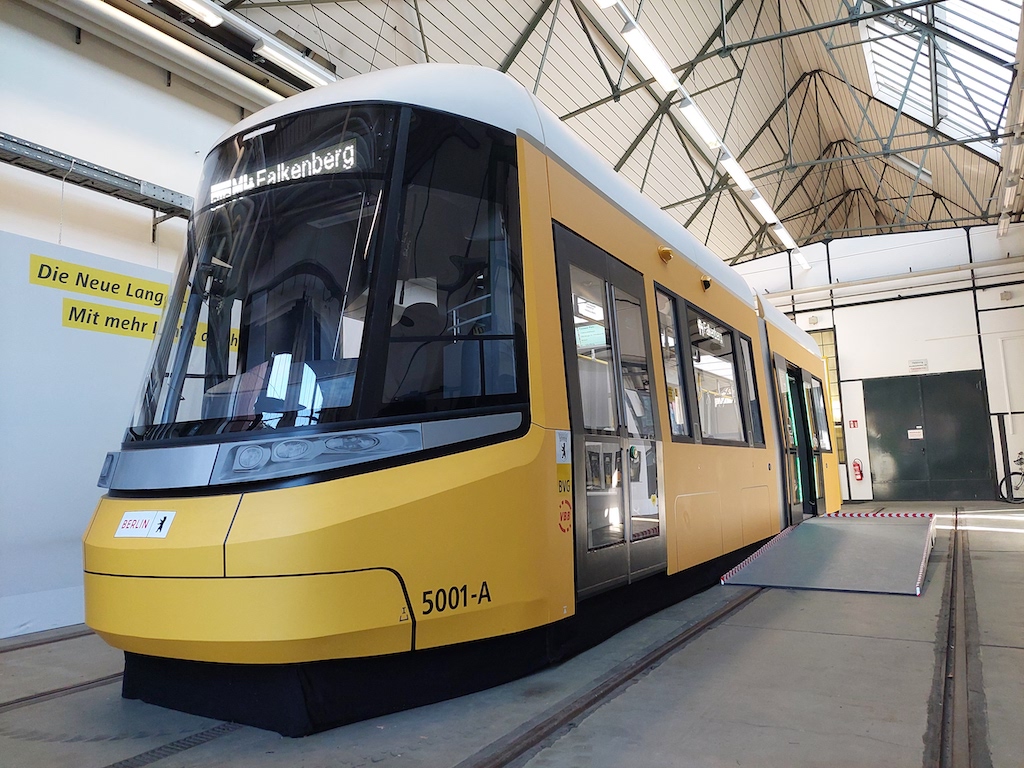
Service vehicles also have to be replaced at some point
Rail vehicles used for internal purposes have not been included in the overview of orders and tenders for very long. Since they are also part of the rolling stock, the authors have decided to include them in the list. The number of enquiries for this is modest and the market of manufacturers specialising in this is manageable. The market leader for urban transport in Germany is the Rheine-based company Windhoff.
Three rail grinding wagons are currently on order (one each for Bielefeld and Duisburg and two for Frankfurt am Main.) Frankfurt has also ordered two multi-function traction units and a rail transport wagon. Bremen has put out to tender a two-way vehicle and Darmstadt a rail grinding wagon. Cologne is currently carrying out a market survey to replace its two-car grinding train from the 1980s.
The current situation of Germany’s underground railways
A look at the four underground railway companies in Germany is also not to be missed. In Berlin, the delivery of the 236 large-profile type J and 140 small-profile type Jk cars ordered from Stadler was originally scheduled for autumn 2022. It is now expected for spring 2023.
After a lengthy development phase, Hamburg put the new generation DT6 vehicles out to tender in autumn 2022. Four-car trains with a length of 40 metres are planned. They will be available for the U5 line under construction, which will be operated in automatic mode, in a version without driver’s cabs (DT6-A) and for the existing network with driver’s cabs as DT6-F. Initially, 14 DT6-A and 14 DT6-F trains are planned. Initially, 14 DT6-A and 34 DT6-F are to be procured; options are planned with driver’s cabs for 250 and without for 72 units.
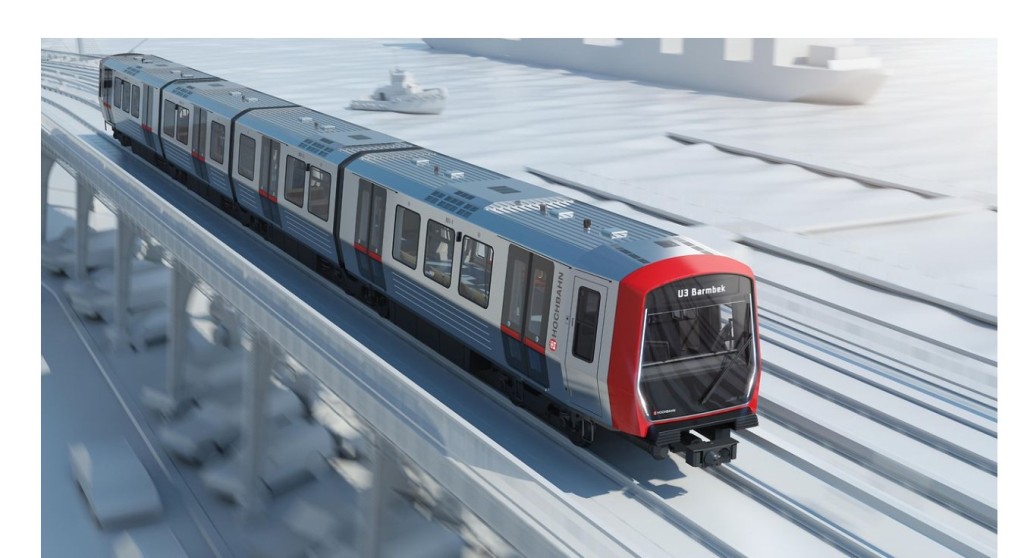
In Munich, the first two units of six-car C2.13 trains from Siemens have been delivered on schedule in 2022. The order comprises a total of 22 units. For delivery from 2024, a further 18 trains were ordered from Siemens in 2022. In Nuremberg, the delivery of the 7 ordered four-car trains of type G1 from Siemens could be completed in 2022. This meant that the last vehicles of the first generation (type DT1 from 1981-84 and DT 2 from 1993) could be taken out of service.
Only a few new tenders for trams and light rail vehicles left
A clear sign that by now almost all companies have placed their orders and options for the replacement of the vehicles from the 1990s is the strongly reduced number of new tenders. The tender for Braunschweig, which was already planned last year, is still pending.
After a long, politically-induced hang-up, Gera announced its tender in February 2023. The tender is for six 38-metre-long multiple units and three options for delivery from 2025 onwards. The difficult financial situation does not allow for more. To be replaced would be high-floor articulated cars of the Tatra type, built from 1981 onwards! Since it is clear that such a small order will be expensive, it is desirable that the vehicles ordered be largely identical in construction to those ordered by other companies. A maintenance partnership with one of the operating companies is also desired. For example, types from the joint orders in Brandenburg and Saxony could be considered for this.
The Kassel tender for 22 low-floor wagons, which are to replace the last high-floor N wagons for bi-directional operation from 1986 and the first generation of low-floor wagons NGT8C from 1990-94, has also been published. Accordingly, both single-direction and bi-directional coaches are required, some of which must also be suitable for use on EBO lines. Delivery is planned between 2025 and 2027, with two additional options for a total of 18 vehicles in 2028-29.
The tender for a large number of high-floor railcars for Cologne has been in preparation since 2021. It was finally published at the beginning of 2023. As a special feature, a new vehicle concept with quick-disconnect connections and optionally extendable sets through intermediate modules is to be implemented. Similar to the wagons already ordered for the low-floor network, two approximately 30-metre-long units form a continuous train of almost 60 metres in length. An additional module, which is placed between the two train halves, creates 70-metre-long trains that can be used on lines with increased passenger volumes and correspondingly adapted platform lengths. It will be interesting to see whether this project will stand up to practical demands!
Initially, five preliminary trains with ten railcars and five centre modules are to be ordered for detailed testing from the end of 2026, followed by series delivery of 122 complete vehicles and 29 centre modules from 2028. Another 60 railcars and 23 modules are planned as options. All light rail vehicles B of the years 1977 to 1996 are to be replaced, but also the K5000 built from 2002 onwards, which, with 25 years of service, has probably reached the end of its service life as a “low cost” vehicle.
The third, also large, tender concerns the metro cars for Hamburg and has already been dealt with in the corresponding section.
Table 1: Vehicles on order or under construction (excl. VDV TramTrains)


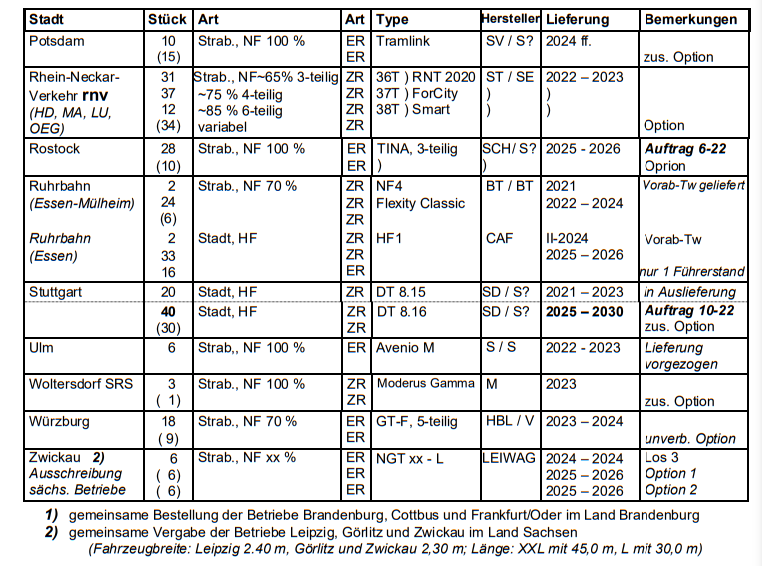
Tabelle 2: Open and expected tenders
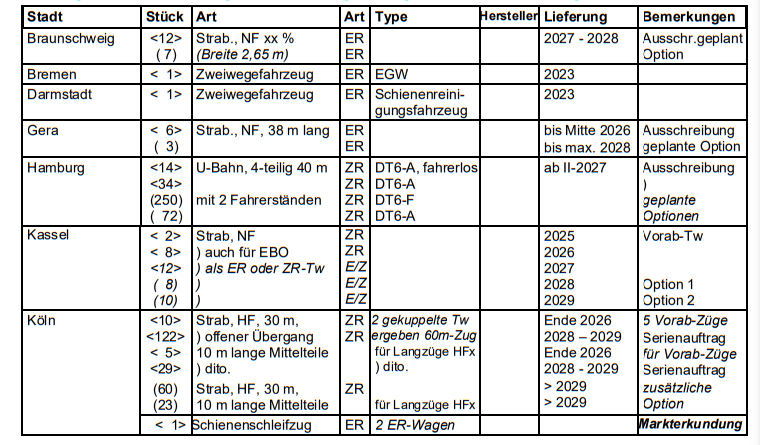
Legend: Number of vehicles: xx = Number of ordered vehicles, <xx> = Number of vehicles which have been tendered, (xx) = Optional vehicles;
Type: vehicle type as used by the respective operators;
Manufacturers (mechanical part/ electrical part): ABB: ABB Switzerland, AT: Alstom Transport, BT: Bombardier Transportation, C: Cegelec, CA: CAF Spain, HBL: HeiterBlick Leipzig, K: Kiepe Electric, SO: Solaris Tram (now: 100 % Stadler), SP: Stadler Pankow, SS: Stadler Switzerland, SU: Stadler Hungary, SV: Stadler Rail Valencia, ST: Škoda Transportation, STF: Škoda Transtech, Finland, SE: Škoda Elektra, S: Siemens Mobility, V: Voith Digital Solutions Austria
Tabelle 3: VDV TramTrain, Orders as per January 2022

Comments to the TramTrain order:
Standard version: three-section, eight-axle 37 m long ZR-Tw (Do-traction = 75 m), three drive bogies (Bo’Bo’2’Bo), air-conditioning of passenger compartment and driver’s compartments, step-less entry at 36 cm.
Variant 1: three-section, eight-axle 37 m long ZR-Tw (Do-traction = 75 m), air-conditioning of passenger and driver compartments, toilet in the middle section, step-free entry at 56 cm (further entry via step [depending on operator] at 34 cm or 38 cm)
Variant 3: three-section, eight-axle 37 m long ER-Tw, 750 V DC, two drive bogies, five doors with entry height 34 cm, air conditioning in passenger and driver compartments, toilet in the middle section, toilet in the driver compartments driver’s compartments
Variant 4: three-section, eight-axle 37 m long ZR-Tw, 750 V DC, air-conditioning in passenger and driver compartments, boarding height 36 cm
Variant 4.1: three-section, eight-axle 37 m long ZR-Tw, 750 ~ 1,000 V DC, air-conditioning in passenger and driver compartments, access at 38 cm
RSBNA Neckar-Alb regional light rail project company
ENAG Erms-Neckar-Bahn between Reutlingen and Tübingen (replaced by RSBNA)
SFBW Schienenfahrzeuggesellschaft Baden-Württemberg procures all trains for AVG and RSBNA
